Oh London! Is it the best city in the world? Answer: probably!
Yes there’s no denying this city is one of my favourites and that’s not least because, even after living here on and off for years, I still haven’t explored it all!
Because London really is the capital where you could spend a lifetime and not see everything.
And that’s exactly why I wanted to bring you this list of the top 25 famous buildings in London you have to visit.
From historical houses to bustling markets, iconic new builds to ceremonial royal specials, here’s the London landmark you must see, no matter whether this is your first, or your fifth, time in the city…
Related Posts
- 7 Top Tips for Solo Travel in London
- London Eye Facts + Visitor Guide
- Top 20 Day Trips from London on a Budget!
Must-See London Icons
I thought it might be best if I divided this list into different types of famous buildings in London, so that you can pick and choose which suits you best.
Kicking things off, we have the historical classics…
#1 Big Ben
Probably London’s most iconic buildings, did you know Big Ben actually refers to not to this famous the clock tower directly, but the bell inside it.
The Great Bell, weighing about 13.5 tons, produces the iconic chimes heard around the world, that have been broadcast by the BBC since New Year’s Eve 1923.
There is probably no other landmark as recognisable, from film, literature or media, as an instant reference to the UK.
As such, this huge icon and central timekeeping figure, is an absolute must-see when you visit the city.
Tours are not yet available for non UK residents, but the view of this towering giant is just as impressive from outside Westminster Abbey, Westminster Station, or from Westminster Bridge over the River Thames.
Sitting at the north end of the Palace of Westminster, this UNESCO-listed gem is a London icon and seeing it, up close, is something you just can’t miss!
#2 Tower Bridge
And straight in with another London classic, Tower Bridge is another landmark in this city you simply can’t miss.
Huge and instantly recognisable, this gigantic bridge spans the River Thames between Southwark and the Tower of London.
Stretching for 244m, 42m above the Thames, it is definitely one of the best strolls you can have while in London, offering panoramic views from its high-level walkways
Inside, the Tower Bridge Exhibition provides fascinating insights into its Victorian engineering and historic significance.
Located within the 2 towers and across the high-level walkways, the exhibition showcases the history, construction, and significance of the bridge through interactive displays, films, and historic photographs.
The exhibition also includes access to the Victorian Engine Rooms, where the original steam engines that once powered the bridge’s bascules (the parts that lift) are on display.
These rooms bring to life the engineering marvel of the 19th century with sounds, visuals, and mechanical models, and are the perfect blend of education, history, and breathtaking views.
Grab your tickets here.
And, if you check the official Tower Bridge website, you can also time getting off the bridge at one of the moments when they raise it for ship access – now that’s a sight to see!
Woven into the fabric of the city, some form of river-spanning structure has been in place here since the Roman ages, which only makes this famous London building even more special in my opinion.
#3 Trafalgar Square
Less a famous building and more a famous square, there’s no way I could put together this list of London landmarks and not mention the iconic Trafalgar Square.
Commemorating the British naval victory in the Battle of Trafalgar in 1805, it was finished in the 1840s and has since developed into a blended historical and cultural public space.
Nearby London’s Charing Cross station, in the heart of the city, this flagship space is famous for its statues, Nelson’s Column and the empty 4th plinth, along with the National Portrait Gallery that sits behind it.
It’s also a central hub of political demonstrations, as well as a spot that most travellers want to glimpse before they walk down The Mall to Buckingham Palace.
Theatreland is also located near Trafalgar Square – the vibrant heart of London’s West End, its home to some of the world’s most famous theatres.
Just a short walk from the square, you’ll find a dazzling array of shows, from classic plays to blockbuster musicals, and the area buzzes with energy, especially in the evening, with visitors and locals alike flocking to venues like the Lyceum, Her Majesty’s Theatre, and the Garrick.
#4 St Paul’s Cathedral
And next up, it’s one of the most famous religious buildings in London!
St Paul’s Cathedral is not only one of the most recognisable structures in London, but its rooftop Galleries also give one of the best views of the city too.
An awe-inspiring stop on any London itinerary, this used to be the tallest building in London until it was overtaken by the Millbank tower in 1963.
It remains the seat of the Bishop of London to this day.
Built after the previous Cathedral burned down in the great fire of London of 1666, this amazing building, designed by Sir Christopher Wren, combines grand Baroque design with sweeping city vistas.
Step inside to admire the soaring dome and the intricate mosaics that line the nave, then test the famous acoustics of the Whispering Gallery, before climbing 528 steps to the Golden Gallery for one of the best skyline views in the capital.
Honestly, climbing up here is an epic way to take in the London skyline and definitely makes buying a ticket to visit St Paul’s worthwhile.
Don’t miss the tranquil crypt either, where national heroes such as Wellington and Nelson are laid to rest, offering a quiet counterpoint to the bustling streets outside.
The cathedral is open for visitors every day of the week, except Sunday, when it is reserved for worship.
Learn all about how to get the best views and photos of this Cathedral in the guide I wrote about visiting St Paul’s.
#5 House of Parliament
And last but not least on this list of the top historical classics in London, it’s the Houses of Parliament.
Otherwise known as the Palaces of Westminster, this seat of democracy and governance is the heartland of Parliamentary power across the UK, and is the meeting place for both the House of Commons and the House of Lords.
Visiting the Houses of Parliament offers a fascinating glimpse into British politics, and guided tours take you through historic rooms, where key decisions shaping the nation are made, including insights into how laws are passed and the role of the monarchy in government.
As you explore the richly decorated chambers, grand corridors, and ancient Westminster Hall – the oldest part of the building dating back to 1097 – you’ll learn about centuries of political history, royal ceremonies, and pivotal debates.
Located along the River Thames, this iconic Gothic building is also home to the famous Big Ben clock tower.
Modern Architecture Spots in London You Can’t Miss
And from the historical to the modern, now we check out those famous new buildings in London – the best modern structures that make this city the great melting pot it is…
#6 The Shard
One of London’s most striking modern landmarks, soaring 310m above the city and designed by architect Renzo Piano, this gleaming glass skyscraper is the tallest building in the UK and Western Europe.
Its unique, shard-like design tapers elegantly into the sky and houses offices, luxury apartments, restaurants, and the five-star Shangri-La Hotel.
One of the main highlights for visitors is The View from The Shard, located on the 68th to 72nd floors, where you can enjoy breathtaking 360-degree views stretching up to 40 miles on a clear day.
From this vantage point, iconic sites like the Tower of London, St Paul’s Cathedral, and the winding Thames come into view like a living map of the city.
Inside, interactive digital telescopes and multimedia displays enrich the experience here with facts and historical context – grab your tickets in advance to skip the queue.
Whether you’re there during the day to spot landmarks, or at sunset for a romantic panorama of twinkling city lights, The Shard offers an unforgettable perspective on London’s blend of historic charm and modern innovation.
#7 Battersea Power Station
Down in southwest London, the Battersea Power Station might not be the most attractive famous London building in many peoples’ eyes, but it is something of a city icon, thanks to its Modernist structure and its flagship regeneration credentials.
Now housing homes, as well as bars, restaurants, shops and entertainment venues, this massive, Grade II listed, former power station (yes the clue is in the name!), tells quite the story about how London is a city constantly able to reinvent itself!
Lift 109 at Battersea Power Station offers a unique and immersive experience, combining industrial heritage with modern innovation.
Visitors begin their journey in the Art Deco Turbine Hall A, where interactive exhibits and multimedia displays detail the power station’s rich history and architectural significance.
The highlight is the ascent in a circular glass elevator that travels up the interior of one of the iconic chimneys, reaching a height of 109 meters.
As the lift ascends, dynamic lighting and soundscapes enhance the experience, culminating in a 360-degree panoramic view of London’s skyline, including landmarks like The Shard and the London Eye.
This experience not only offers breathtaking views, but also provides insight into the transformation of a historic power station into a modern cultural destination.
#8 The Gherkin
Back in the City of London, it has to be said The Gherkin has always looked more like a bullet to me but, to everyone else, it apparently looks like a gherkin!
This distinctive black and glass tall building, with its wrap-around, tapered look is officially known as 30 St Mary Axe, and is one of London’s most distinctive and recognisable skyscrapers.
Standing 180m tall in the heart of the City of London, this iconic, bullet-shaped building was designed by Sir Norman Foster and completed in 2003.
Its futuristic, curved design isn’t just for show – it also serves an environmental purpose, using natural ventilation and energy-efficient systems to reduce its carbon footprint.
Clad in spiralling bands of glass and steel, The Gherkin stands out among the city’s skyline, symbolising London’s modern, forward-thinking architecture.
While it primarily houses offices, the top floors offer a stunning 360-degree view of the city, and are often used for exclusive events.
The building is especially striking at night when it lights up against the dark sky, acting as a glowing beacon of innovation in the historic financial district.
Whether admired from the street or viewed from above, The Gherkin represents the perfect blend of cutting-edge design, sustainability, and urban sophistication.
#9 The Walkie Talkie
And not far away – just a little closer to the River Thames – I’m delighted to say the Walkie Talkie building does look more like the informal name it has been given than the Gherkin!
Officially known as 20 Fenchurch Street, this is one of London’s most eye-catching skyscrapers, known for its distinctive top-heavy, curving design that resembles a two-way radio handset.
Completed in 2014 and designed by architect Rafael Viñoly, the 160m tall building stands out not only for its unusual shape, but also for the panoramic public space at its summit – the famous Sky Garden.
Spanning 3 storeys at the top of the tower, the Sky Garden features lush indoor landscaping, observation decks, an open-air terrace, and several restaurants and bars, all offering stunning 360-degree views of the London skyline.
Entry to the Sky Garden is free with advance booking, making it one of the most accessible ways to enjoy a high-rise perspective of the city.
Despite some initial controversy over its design – including a notorious incident where its curved glass reflected intense sunlight and damaged cars below, whoops! – the Walkie Talkie has become a beloved fixture of the London skyline.
#10 London Eye
And another addition to the city’s skyline, down by the river but this time on the south side, is the huge ferris wheel that is the London Eye.
Opened in 2000, 2025 marks the 25th anniversary of the London Eye, which was meant to be a temporary structure, but continues to attract some 3.5 million visitors a year… and is here to stay!
The capsules (or pods), are all air conditioned and hold up to 25 passengers each, who can experience a 30 minute ride that takes in unobstructed 360 degree panoramic views of the city.
A superb way to orientate yourself and take in many of the famous buildings on this list, grab your skip the line tickets for the London Eye in advance here.
Paying a little extra for these fast track entry tickets is well worth it in my opinion – when I visited, they allowed me to reach the pods within 10 minutes of joining the queue, rather than lining up for 45 minutes in the regular ticket queue.
To add even more fun to the experience, get there by Uber river boat or enjoy a London River Cruise afterwards.
Royal Family Buildings to Visit in London
And now we move onto those famous London landmarks that boast some pretty impressive regal connections.
Even if you’re not a fan of the Monarchy, it’s hard to visit London and not see at least one of the buildings connected to the Royal family.
A classic part of the history of London and the UK in general, whether you’re a fan of The Crown or not, it’s hard to ignore the pomp and grandeur this famous family bring to the city.
#11 Buckingham Palace
Straight in at number 11 on this list of the most famous buildings in London you have to visit, it’s the monarch’s official residence, Buckingham Palace.
Situated at the heart of Westminster, the palace has been the home of the royal family since 1837 and serves as a focal point for national celebrations and state occasions.
Visitors to Buckingham Palace can experience its grandeur firsthand, especially during the summer months when the State Rooms open to the public – tickets need to be booked in advance.
Inside, guests are treated to a glimpse of the opulent interiors, featuring stunning artworks, exquisite furnishings, and the famous Throne Room used for ceremonial events.
One of the highlights of visiting the palace all year round, is witnessing the Changing of the Guard, a colourful and highly choreographed ceremony that takes place outside the gates and draws crowds at 11am for a 45 minute free show.
Get there at 10:30am latest, if you want to be in with a chance of seeing anything!
Whether you’re captivated by the rich history, fascinated by royal traditions, or simply want to see the residence of the monarch, visiting Buckingham Palace offers a unique window into the heritage and pageantry the British are famous for!
#12 Hampton Court
Now we move to the home of a former Royal, that of Henry VIII.
Hampton Court Palace is a magnificent historic royal residence located on the banks of the River Thames, just outside central London.
Built in the early 16th century for Cardinal Thomas Wolsey, before becoming a favourite home of King Henry VIII, the palace offers visitors a fascinating journey through Tudor and Stuart history.
When you visit Hampton Court, you can explore its stunning state apartments filled with rich tapestries, grand paintings, and ornate furnishings that reflect centuries of royal life.
The famous Tudor kitchens, where elaborate feasts were once prepared, provide a unique glimpse into the workings behind the scenes of the palace.
Beyond the interiors, the vast and beautifully landscaped gardens are a highlight, featuring formal parterres (a formal garden characterised by symmetrical patterns, low hedges, and gravel paths), a maze that has delighted visitors for centuries, and the peaceful Privy Garden.
Throughout the year, Hampton Court hosts a variety of events, including historical reenactments, outdoor theatre, and seasonal festivals that bring the palace’s history to life.
With its blend of architectural grandeur, rich royal history, and stunning grounds, Hampton Court Palace offers an unforgettable experience for history lovers, families, and anyone curious about England’s royal heritage.
Book tickets in advance of your visit here and get ready to enjoy some amazing gardens, as well as historic exhibitions and events that are great for adults and kids alike.
#13 Kensington Palace
Next up on the Royal connections list, it’s time to head to the home of some current members of the Royal Family, and that is the beautiful Kensington Palace.
Nestled in the heart of Kensington Gardens, the Palace is a royal residence rich in history, elegance, and modern-day relevance.
Once the childhood home of Queen Victoria and later the residence of Princess Diana, it continues to be a working royal palace, currently housing members of the royal family including the Prince and Princess of Wales.
Visitors to Kensington Palace can explore beautifully preserved State Apartments, where stunning Georgian and Victorian architecture meets interactive exhibits and royal artefacts.
The rooms reveal personal stories of the monarchs who lived there, from Queen Mary II’s love of exotic decorations, to the intimate details of Queen Victoria’s early life.
One of the highlights is the exhibition space, which frequently features displays focused on fashion, royal portraits, and the lives of modern royals, including Diana’s iconic wardrobe.
Outside, the Sunken Garden – now famous as the site of the statue of Princess Diana – is a tranquil space filled with seasonal flowers and reflective beauty.
A visit to Kensington Palace offers a unique blend of historical insight and contemporary royal connections, making it a must-see destination for anyone interested in the British monarchy and its legacy.
#14 Tower of London
Another amazingly famous building in London – it’s the UNESCO-listed Tower of London!
One of the most iconic and historically rich landmarks in Britain, standing as a powerful symbol of the country’s medieval past, royal legacy, and political intrigue, it was founded by William the Conqueror in 1066.
Since then, this imposing fortress has served as a royal palace, a prison, a treasury, and even a zoo!
Today, visitors can explore its ancient stone walls, towers, and passageways while uncovering dramatic tales of betrayal, imprisonment, and execution.
The Tower is perhaps most famously known for housing the Crown Jewels, a dazzling collection of royal regalia still used in coronations and state ceremonies, including the magnificent Imperial State Crown.
Guided tours by the Yeoman Warders (also known as Beefeaters) bring the Tower’s history to life with fascinating stories and sharp wit.
Visitors can also see the ravens, which, according to legend, must remain on the grounds to prevent the fall of the kingdom.
From the haunting beauty of the White Tower, to the solemn execution site of queens like Anne Boleyn, the Tower of London offers a gripping and immersive journey through centuries of British history, which always captivates both adults and children alike.
The after-hours Ceremony of the Keys is one of the most personal experiences you can have at the Tower, with only 1 small group allowed to see this 700 year old nightly ritual.
Otherwise grab your daytime tickets for the Tower of London and Crown Jewels in advance here.
#15 Westminster Abbey
And last but not least on this list of famous buildings in London with Royal connections, we come to Westminster Abbey.
Like St Paul’s, this another of the city’s classic Christian structures, with some pretty special connections to the House of Windsor – this has been the site of all British coronations since 1066, and was the venue for the funerals, of both Queen Elizabeth II and Princess Diana.
As such, it really holds a central place in the national consciousness.
A masterpiece of Gothic architecture that has stood for over a thousand years in the heart of London, visitors to Westminster Abbey are immersed in centuries of history as they walk through its magnificent nave, marvel at the intricate fan-vaulted ceilings, and stand before the Coronation Chair, which has been used in nearly every coronation for over 700 years.
The Abbey is also a place of remembrance, home to the Tomb of the Unknown Warrior and the resting place of some of the country’s greatest figures, including Isaac Newton, Charles Darwin, Geoffrey Chaucer, and Stephen Hawking in Poets’ Corner.
Guided tours of Westminster Abbey can be enjoyed, otherwise general entrance tickets will allow you to access parts of this huge Church and learn more about its history, as well as its future.
Famous London Markets
And from famous buildings to foodie paradises, next on this list of London landmarks, it’s time to turn our attention to some of the city’s most famous market places.
Many have now been converted into amazing modern spaces with shops and cafes, but they all still retain parts of their iconic heritage features too – how delightful!
If you’re a big market fan, then Spitalfields Market in east London, as well as Portobello in west London didn’t make this top-list, but are well worth a visit as well.
#16 Covent Garden Market
Covent Garden is one of London’s most vibrant and atmospheric districts, blending rich history, cultural charm, and lively entertainment in a single, pedestrian-friendly destination.
Originally a bustling fruit and vegetable market dating back to the 17th century, Covent Garden has evolved into a stylish hub filled with boutique shops, artisan stalls, street performers, world-class restaurants, great cafes and iconic theatres like the Royal Opera House.
At the heart of the area lies the elegant Piazza, where visitors can relax under the glass-roofed market building, browse handmade crafts and luxury goods, or watch talented street artists and musicians captivate passing crowds.
The surrounding cobbled streets and hidden alleyways are filled with unique finds – from independent fashion labels to quirky gift shops and gourmet food spots.
Covent Garden is also home to a rich blend of culture and entertainment, offering everything from opera and ballet to immersive art exhibitions and pop-up installations.
The festive period is a particularly wonderful time to visit, when the whole area is beautifully illuminated.
Whether you’re looking to shop, dine, soak up London’s creative spirit, or simply enjoy the vibrant atmosphere, visiting Covent Garden provides an unforgettable experience that captures the eclectic energy and timeless charm of the city.
#17 Leadenhall Market
Next up, it’s another classic market in London, the wonderful Leadenhall, which dates back to the 14th century and is Grade II listed.
A hidden gem in the heart of London’s financial district, it boasts a striking blend of Victorian elegance, historic charm, and modern flair, after being rebuilt in the 19th century with ornate wrought iron and glass roofing.
As such, the market boasts a beautifully preserved architectural style that makes it one of the most picturesque spots in the city.
Visitors are immediately drawn in by its cobbled walkways, vibrant red and gold detailing, and warm, atmospheric lighting.
Once a hub for meat and poultry traders, Leadenhall now houses an eclectic mix of boutique shops, stylish pubs, cafés, and restaurants, making it a popular spot for both lunch breaks and leisurely strolls.
The market has also gained fame as a filming location for movies like Harry Potter and the Philosopher’s Stone, further enhancing its appeal for fans and tourists alike.
Conveniently located near iconic sites like the Gherkin and the Bank of England, Leadenhall Market offers a unique blend of history, culture, and culinary delights, making it a must-visit destination for anyone wanting to experience a lesser-known, but equally captivating, side of London.
#18 Borough Market
And last but not least on this list of the top London markets, Borough Market (just south of the River and very near to London Bridge) is an absolute foodie paradise, and one of London’s oldest and most celebrated food markets.
A sensory paradise for food lovers tucked beneath the railway arches near London Bridge, with origins dating back over 1,000 years, the market has evolved into a vibrant and diverse culinary destination that brings together traditional British fare and global gourmet flavours.
As you wander through the bustling stalls, you’re met with the irresistible sights and smells of fresh produce, artisanal cheeses, baked goods, street food, and international delicacies from around the world.
From hand-crafted pies and aged charcuterie, to exotic spices, vegan innovations, and locally brewed craft beers, Borough Market offers something to satisfy every palate.
The market is not just a place to eat – it’s a lively community hub, with an atmosphere that’s both authentic and electric – a mix of Londoners, tourists, and chefs creating a constant buzz.
Nearby, you can explore Southwark Cathedral, the River Thames, and The Shard, making the market an ideal stop during a day of sightseeing.
Whether you’re grabbing a quick bite, stocking up on gourmet goods, or soaking up the atmosphere, a visit to Borough Market is a delicious and unforgettable experience that captures the heart of London’s food culture.
Cultural London Buildings
And now we move onto the cultural spaces on this list of top London landmarks.
After all, if London is famous for anything, it’s as a city of art and culture, a capital that looks to its future as well as to its past…
#19 Victoria and Albert Museum
Over in South Kensington in west London, there’s no doubt the Victoria and Albert Museum is one of the city’s best cultural spots.
Founded in 1852, this is the world’s largest museum of applied and decorative arts and design, which means it contains a vast array of incredible artefacts you shouldn’t miss the chance to explore.
With some amazing revolving exhibitions you’d be forgiven for thinking it’s all about the interior here, but wonderfully, the ornate and recognisable huge, red brick exterior is stunning too!
The nearby Natural History Museum is another beautiful London building and fab day out if you’re in the South Kensington area is to pair the 2.
#20 Royal Observatory in Greenwich
And from west London to south of the river, now we move to the wonderful area of Greenwich, which sits on the river and is home to a lovely market, high street, museum and park too.
I should know – I used to live near here back in the day!
However, it’s not the market, high street, museum or park I want to draw your attention to here, although they are all great and worth a visit too!
No instead, it’s the amazing Royal Observatory, which is actually located on top of a hill within the park.
The place where the world time system is measured from, the Meridian Line can be walked here, this awesome space also houses London’s only planetarium and is the historic home of British astronomy too.
Plenty to get your teeth into, the Observatory is a beautiful building which, elevated above the park and river, is pretty striking to say the least!
Get your tickets here.
#21 Tate Modern
And from the historic to the modern, the Tate Modern in fact!
The UK’s leading contemporary art museums, the Tate Modern is situated along the Southbank at the end of the Millennium Bridge – which is another London landmark you should visit by the way!
One of London’s most dynamic and influential cultural institutions, housed in a striking former power station, it offers a thought-provoking and ever-evolving experience for visitors of all backgrounds.
Inside its vast industrial spaces – especially the iconic Turbine Hall – visitors encounter an extraordinary collection of artworks by some of the world’s most renowned artists, including Pablo Picasso, Andy Warhol, Yayoi Kusama, and Mark Rothko.
The galleries span a wide range of mediums and movements, from surrealism and minimalism, performance art to immersive installations, which encourage curiosity and reflection.
Admission to the main collection is free, making it one of the most accessible art institutions in the world, while temporary exhibitions and events add fresh perspectives throughout the year.
Beyond the art, Tate Modern’s riverside location offers stunning views of the Millennium Bridge, St Paul’s Cathedral, and the London skyline from its upper-level terrace.
Whether you’re an art enthusiast, a curious traveller, or simply looking for inspiration, a visit to Tate Modern promises a bold and memorable journey through the ideas and expressions that shape contemporary British culture.
#22 Alexandra Palace
And now we travel up to north London and on to Alexandra Palace.
Affectionately known as “Ally Pally,” this is a beloved North London landmark that combines rich history, stunning architecture, and a diverse range of entertainment and leisure activities.
Originally opened in 1873 as a “People’s Palace” for public recreation and culture, it has since become an iconic venue with breathtaking panoramic views over the London skyline.
Set within 196 acres of parkland, Alexandra Palace is a haven for both locals and visitors looking to escape the hustle of the city.
Inside, the palace hosts everything from live music concerts and theatre performances to exhibitions, food festivals, and sporting events.
It’s also home to an indoor ice rink, a boating lake, a garden centre, and regular farmers’ markets, making it a destination that caters to all ages and interests.
The building itself is steeped in broadcasting history, famously serving as the birthplace of BBC television in 1936.
A visit to Ally Pally isn’t just about attending an event – it’s about soaking in the vibrant atmosphere, enjoying a walk through its beautiful grounds, and experiencing a piece of living London heritage that continues to evolve while honouring its rich past.
#23 Royal Albert Hall
The Royal Albert Hall is one of London’s most prestigious and visually stunning venues, steeped in history and renowned for its world-class performances and iconic architecture.
Opened in 1871 by Queen Victoria in memory of her husband Prince Albert, the hall has since become a symbol of British culture and artistic excellence.
Its distinctive circular design and majestic domed roof create not only a striking presence in South Kensington but also near-perfect acoustics, making it a favourite among performers and audiences alike.
The Royal Albert Hall hosts an incredibly diverse program of events, ranging from classical concerts and opera to rock shows, ballet, comedy, and even film screenings with live orchestras.
It is famously home to the BBC Proms, an annual summer celebration of classical music that culminates in the exuberant Last Night of the Proms.
Visitors can explore the venue on guided tours, which offer fascinating insights into its royal origins, behind-the-scenes workings, and legendary past performances by artists such as Adele, Elton John, and Luciano Pavarotti.
The interior is equally breathtaking, with plush red seating, grand staircases, and the iconic “mushroom” acoustic diffusers hanging from the ceiling.
Whether attending a live event or simply touring the historic halls, a visit to the Royal Albert Hall is an inspiring experience that showcases the grandeur and cultural richness of London’s artistic heritage.
Top Green Spaces & Parks in London
And finally we come to London’s greens spaces!
I could go on and on here about the number of parks I love in this city, because there really as so many to choose from, but I think I’ve done very well and kept it to a maximum of 2!
Here they are…
#24 Victorian Greenhouse at Kew
In at number 24, it’s the fabulous botanical Kew Gardens down in southwest London and the wonderful Victorian Greenhouse here, which has to be one of London’s most famous buildings.
Formally known as the Temperate House, this is the largest surviving Victorian glasshouse in the world and one of the crown jewels of the Royal Botanic Gardens at Kew.
Reopened in 2018, after a 5 year, multi-million-pound restoration, this stunning structure is a masterpiece of 19th century architecture, with soaring ironwork, intricate detailing, and nearly 15,000 panes of glass.
Inside, visitors are transported into a lush, climate-controlled world that houses over 1,500 species of rare and endangered plants from temperate regions across the globe – from towering tree ferns and exotic palms, to vibrant flowering shrubs and medicinal herbs.
Walking through the Temperate House is like taking a global botanical journey, offering both scientific insight and visual splendour.
Elevated walkways allow visitors to admire the canopy from above, while interpretive displays share stories of conservation and ecological significance.
The building itself is a marvel, blending engineering innovation with aesthetic beauty, and it reflects the Victorian passion for exploration and the natural sciences.
Surrounded by the expansive and beautifully curated grounds of Kew Gardens, a visit to the Temperate House offers not only a deep appreciation of plant life, but also a serene and inspiring experience in one of the world’s most important botanical institutions.
It has to be seen to be believed, so get your admission tickets here!
#25 Regent’s Park & Primrose Hill
And of course, how could we get through this list and not mention Regent’s Park.
One of the grandest, oldest and most central parks in London, Regent’s Park is home to Queen Mary’s Gardens, which boast over 12,000 roses, as well as tranquil boating lakes, tennis courts, and even the world-famous ZSL London Zoo – it’s massive and you could easily spend a day here, taking it all in!
One of London’s eight Royal Parks (my other fav is Windsor), Regent’s Park covers an area of 395 acres and is free to enter daily from dawn to dusk.
Offering a perfect blend of landscaped beauty, recreational activities, and breathtaking views, the park was designed by famed architect John Nash in the early 19th century.
Adjacent to the park lies Primrose Hill, a gently sloping grassy rise that rewards those who climb it with one of the most iconic panoramic views of the London skyline, stretching from the London Eye and The Shard to St Paul’s Cathedral.
The area around Primrose Hill also has a charming village-like atmosphere, with quaint cafés, boutiques, and pastel-coloured houses, making it ideal for a leisurely afternoon.
Whether you’re taking a peaceful morning jog, admiring seasonal blooms, watching theatre at the Open Air Theatre, or catching the sunset from the hilltop, a visit to Regent’s Park and Primrose Hill offers a refreshing and scenic escape that beautifully captures London’s blend of nature, culture, and community.
Just enter your details below and I'll email it to you - simple!
Information will be sent to the email provided above
View this post on Instagram
Mini Travel Guide to London
When to Visit London?
I’d definitely recommend visiting London in the summer, when the better weather at this time will allow you to enjoy all the wonderful attractions, gardens, markets, squares, stations and statues of this world-class city.
Just remember weekends, especially during the school summer holidays, can get very busy here and are probably best avoided!
Accommodation tends to be cheaper mid-week and out-of-season too.
Check out these top central London hotels.
How to Travel to London?
Fly to either London Heathrow, London Luton, London Stansted or London Gatwick.
As always, I use Skyscanner to find the best flight prices.
You can also get the Eurostar from Amsterdam, Bruges or Paris to London.
Book via Trainline.
How Long to Visit London For?
Look, you could easily spend a month (or a year!) in London and not see it all!
To take in the 25 famous buildings on this list, as well as some of the other fun this city has to offer, I’d recommend a minimum of 4-6 days.
Top London Tours & Passes
A great way to get acquainted with London and its famous buildings, especially if this is your first trip to the city, is to enjoy a bus, boat, walking or cycling tour.
There’s loads of different ones to choose from here, so check out my pick of the bunch and book the one that suits you best – it will provide a great intro to this city’s history, culture and geography.
And if you plan to visit a lot of attractions in the capital, I’d also consider grabbing a London Pass – this is a great way to keep the costs of visiting lots of attractions (and getting around the city) down.
Check out these top options…
- London Pass – Choose from 1, 2, 3, 6, or 10 day options. This pass is best for short-term London visitors and includes many of the attractions and landmarks mentioned in this post.
- London Explorer Pass – Pick a 2, 3, 5 or 7 attraction pass and experience London over 60 days. This option is better for longer-term London visitors and includes many of the buildings mentioned in this post.
Where to Stay in East London?
There’s just too many different areas of London, let alone accommodation choices, to name here, so I’m going to concentrate on the budget end of the market and the east of London, because these are what I know best!
East London tends to be known for being quite liberal, arty, progressive, young and alternative, so if that’s your vibe too, check out these good affordable options in what is the most fun part of the city IMO!
- Z Shoreditch
- Prime Backpackers Angel
- KIP Hotel Shoreditch
- Kingsland Locke Shoreditch
- Mama Shelter London
Travel Insurance
World Nomads offers simple and flexible travel insurance. Buy at home or while travelling and claim online from anywhere in the world.
Alternatively, if you’re a long-term traveller, digital nomad or frequent remote worker seeking travel health cover, check out Safetywing’s Nomad Insurance policies.
Travel Money
The UK uses the British Pounds (GBP).
I always travel with my Wise card, which makes spending abroad cheaper with real exchange rates and no sneaky transaction or ATM fees.
Wise cards works just like a debit card and it link easily with Google and Apple pay. Grab yours here.
Luggage Storage
Store your luggage in London for the day, or longer, with LuggageHero.
They have safe and reviewed sites across the city.
SAVE THIS ARTICLE TO PINTEREST!
So there you have it, my list of the 25 most famous buildings in London you can’t miss.
Which on the list is your favourite and which are you still yet to see?
Tell me all in the comments box below…
This page contains affiliate links meaning Big World Small Pockets may receive a small commission on any purchases at no extra cost to you.

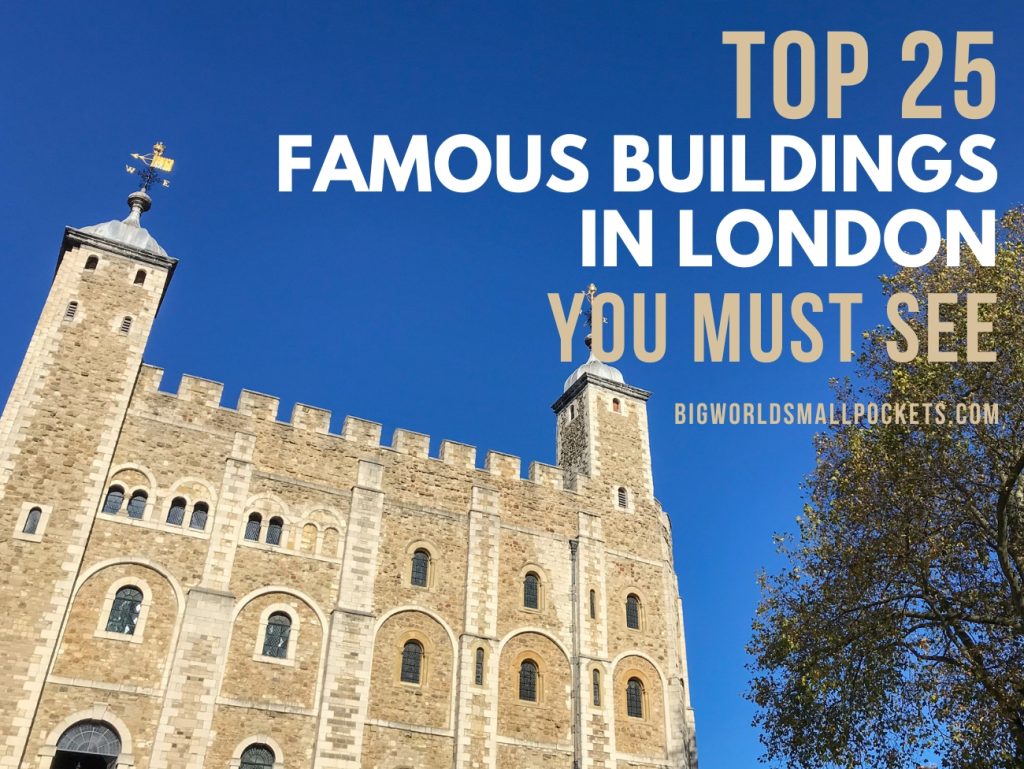
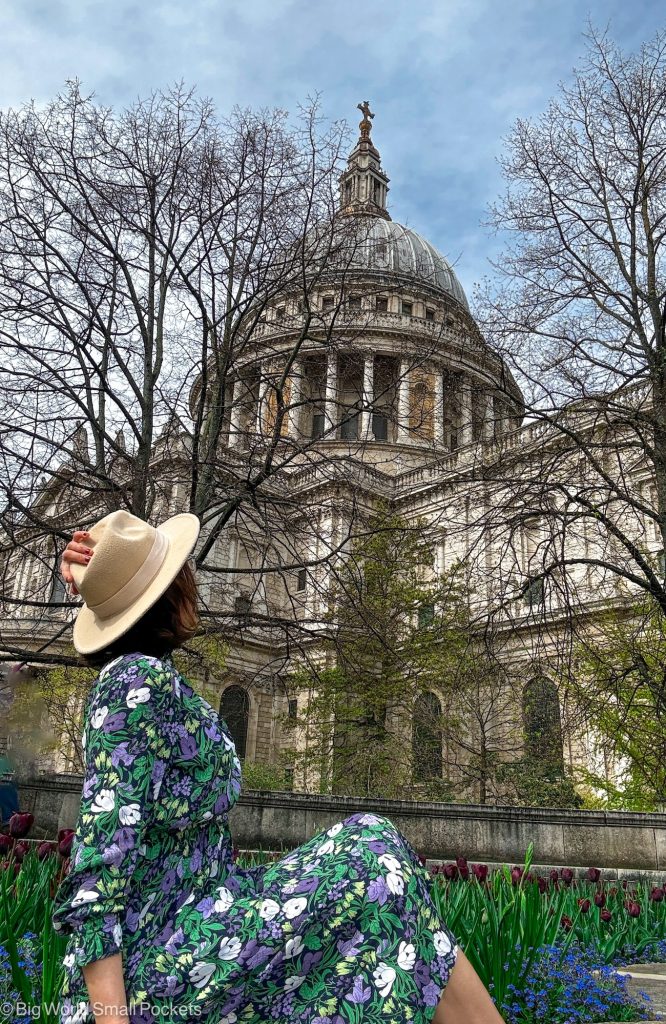
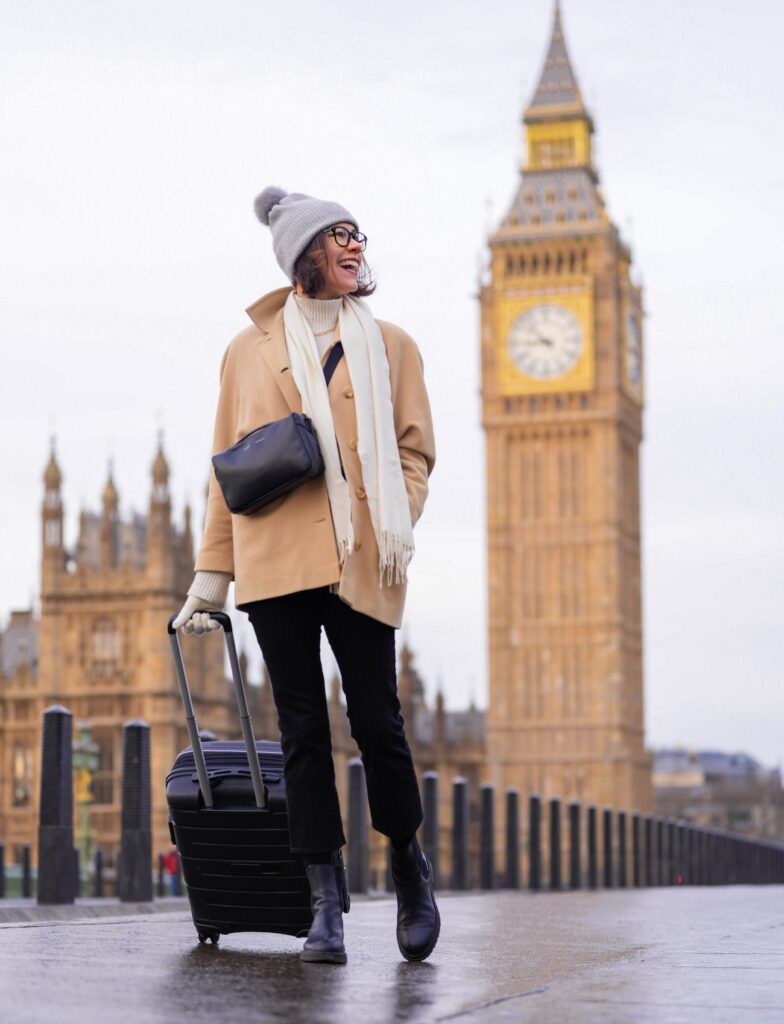
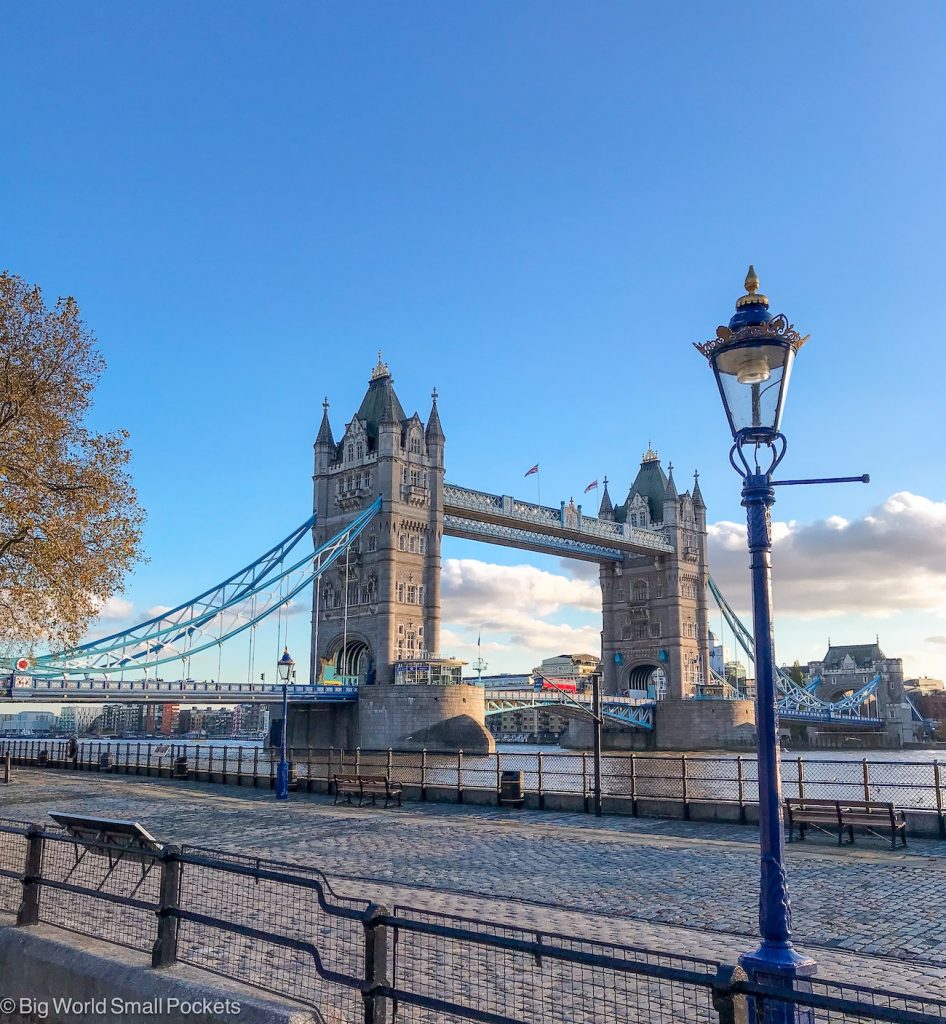
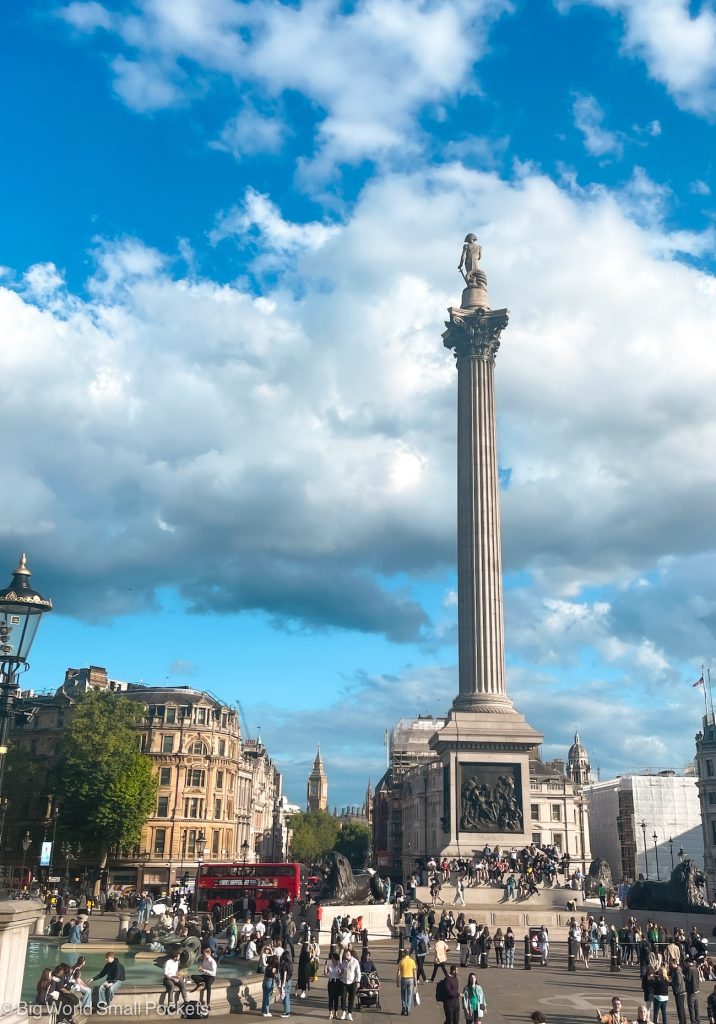
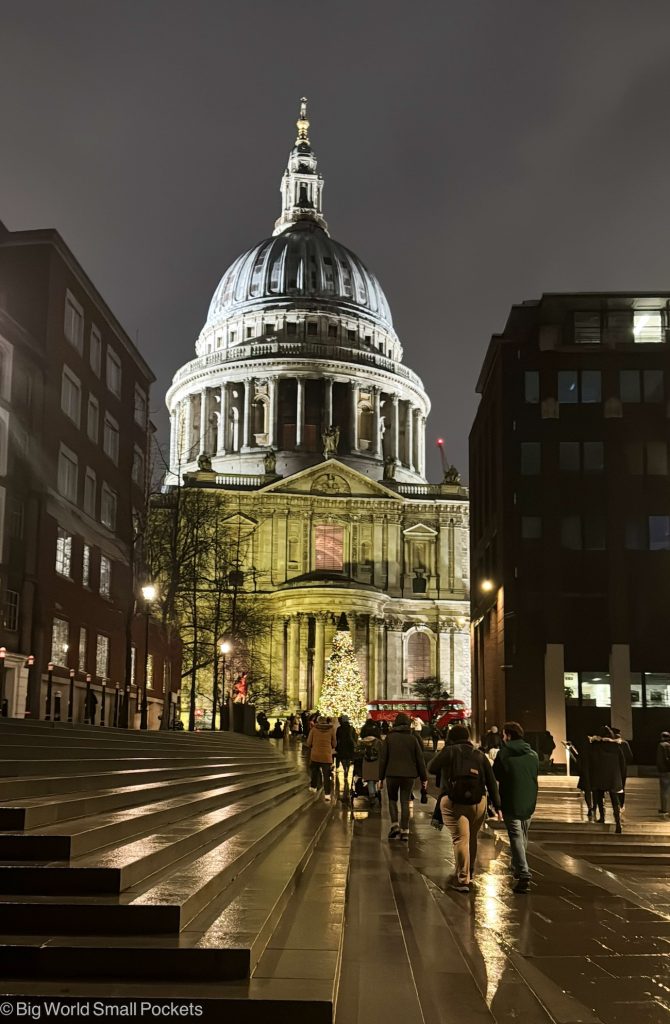

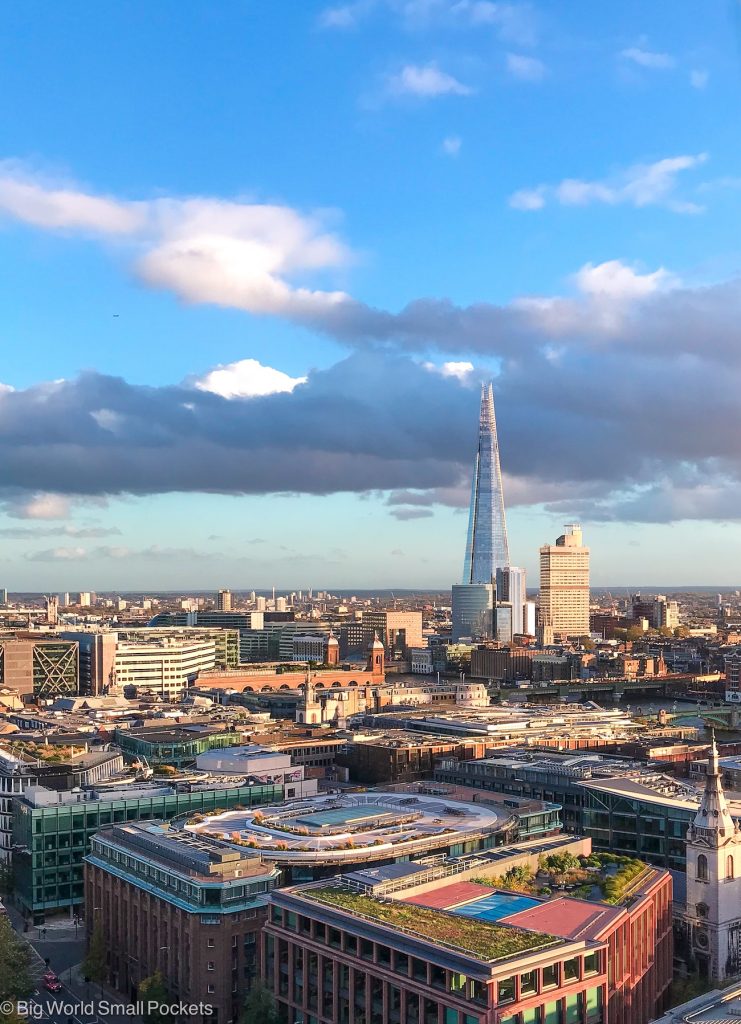
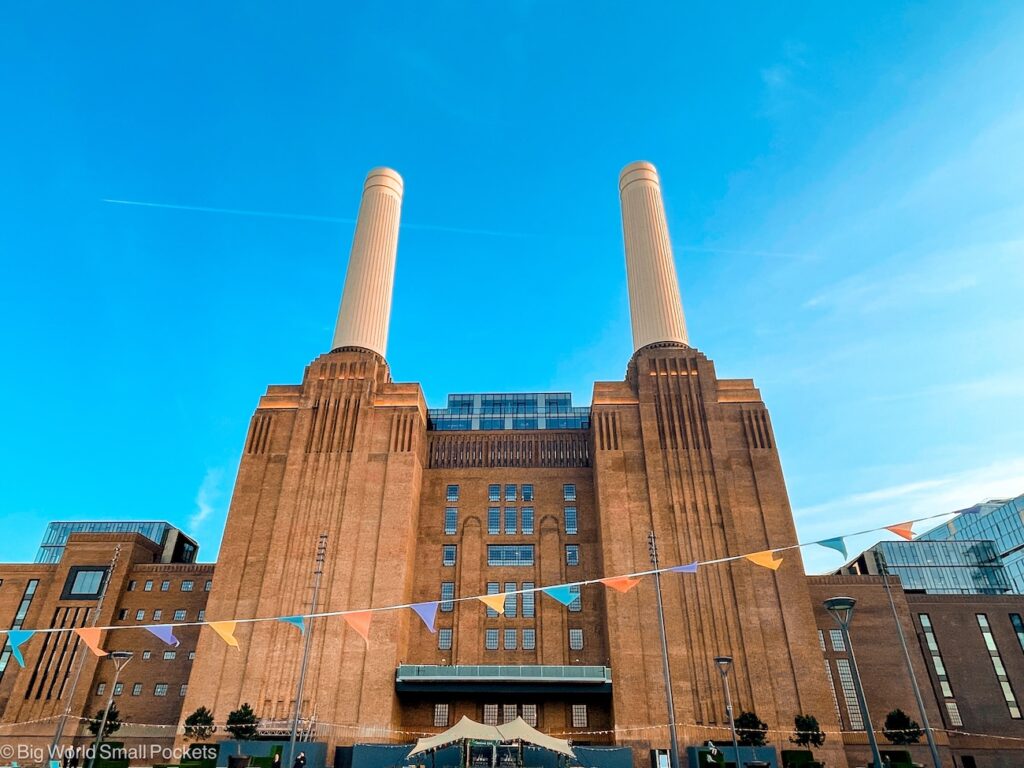


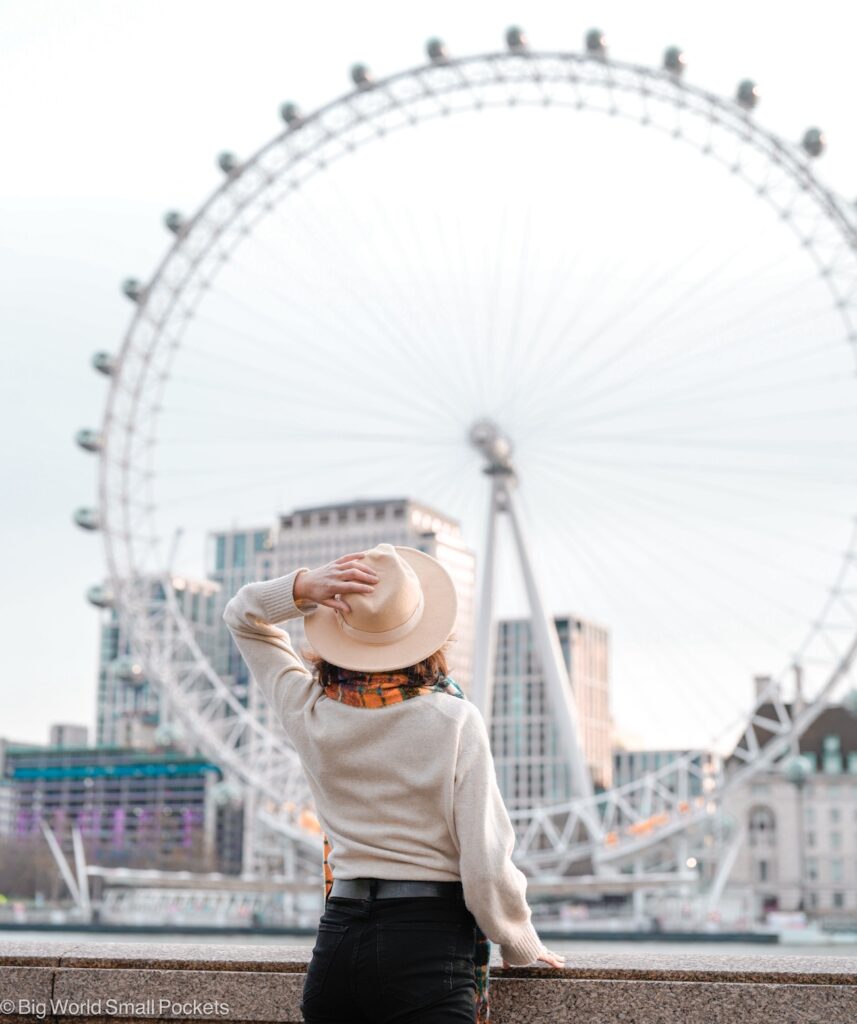
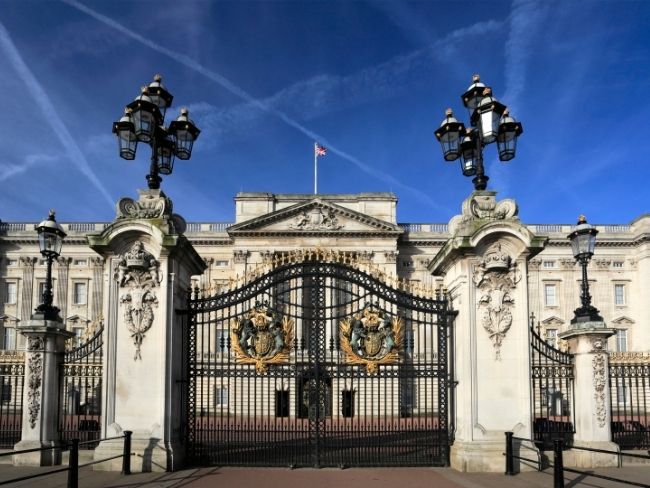
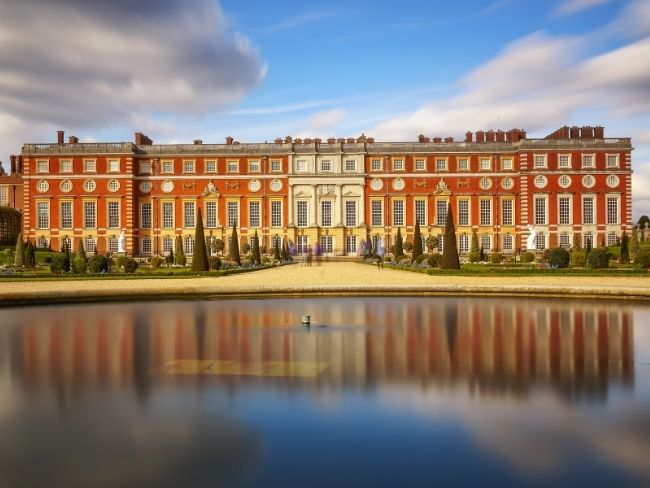
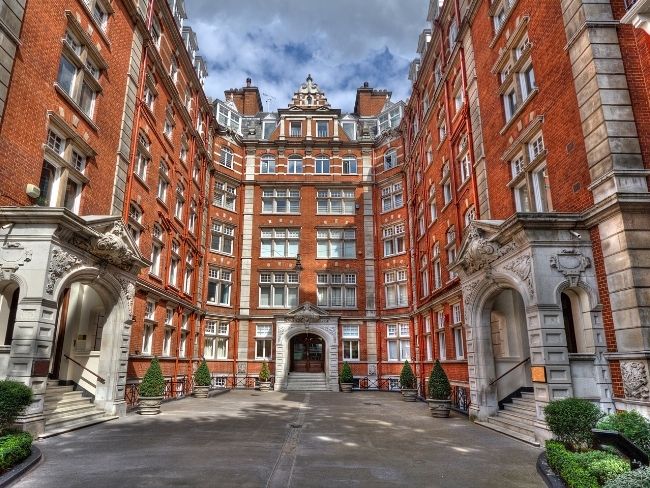
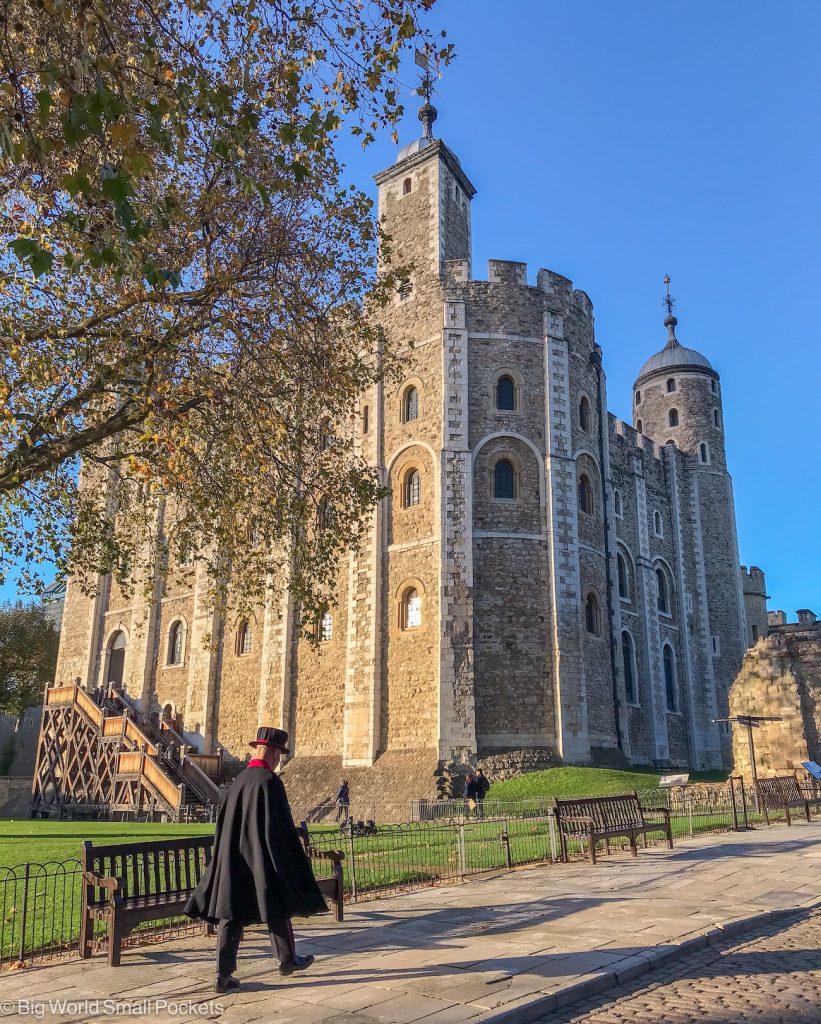
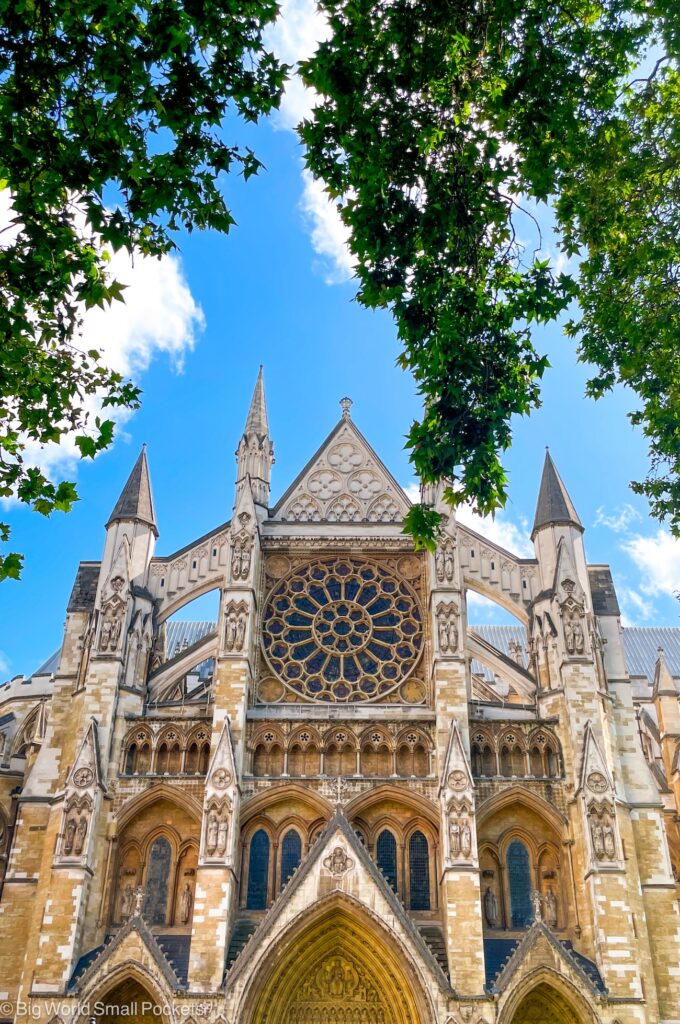

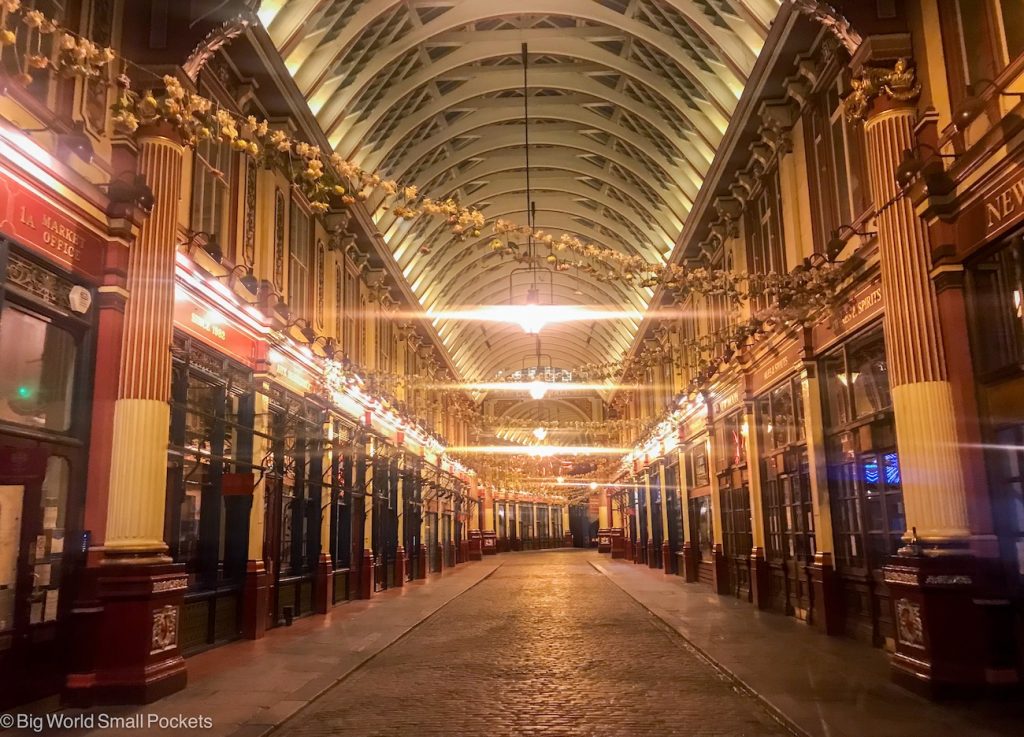
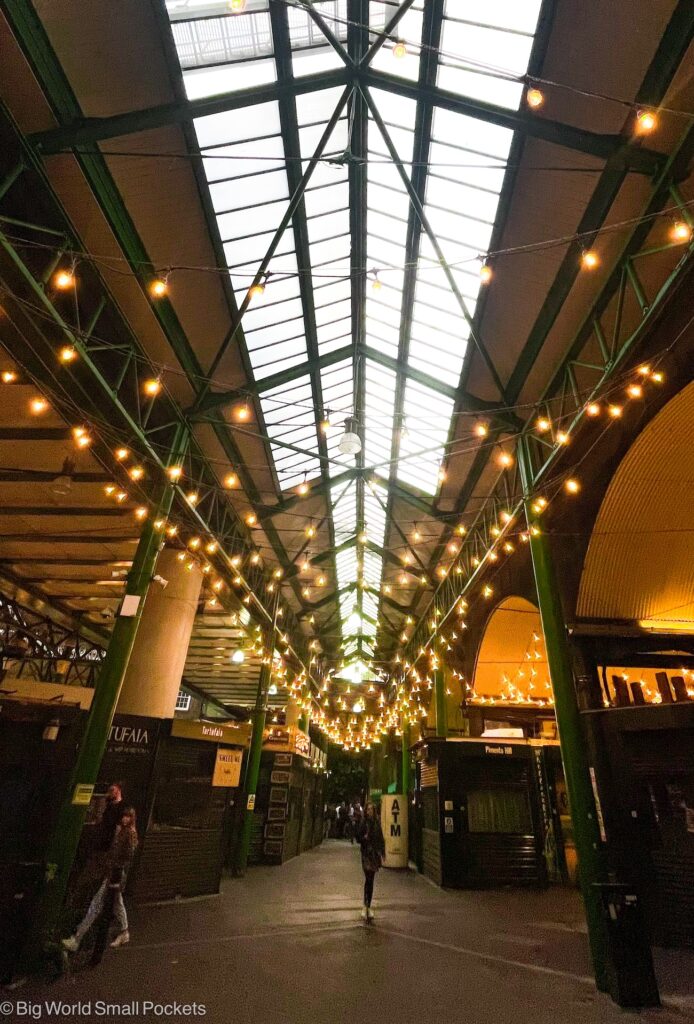
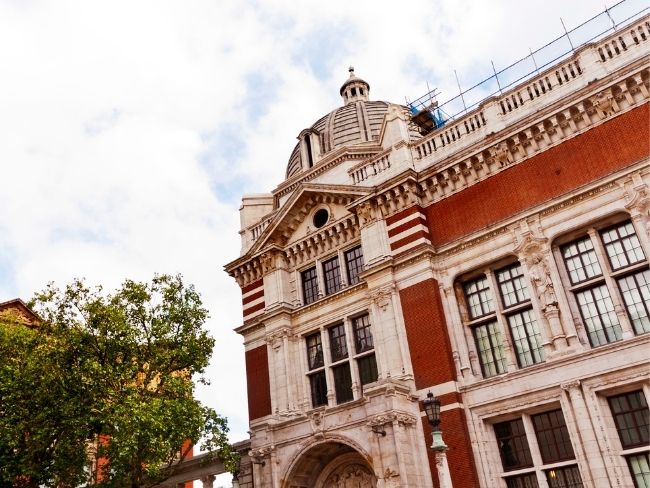
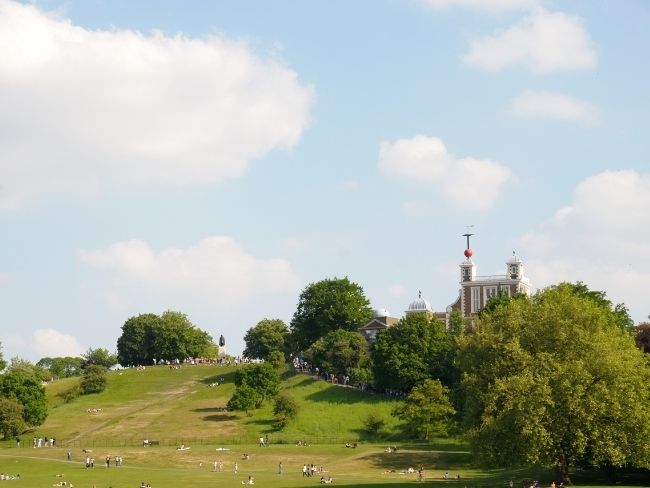
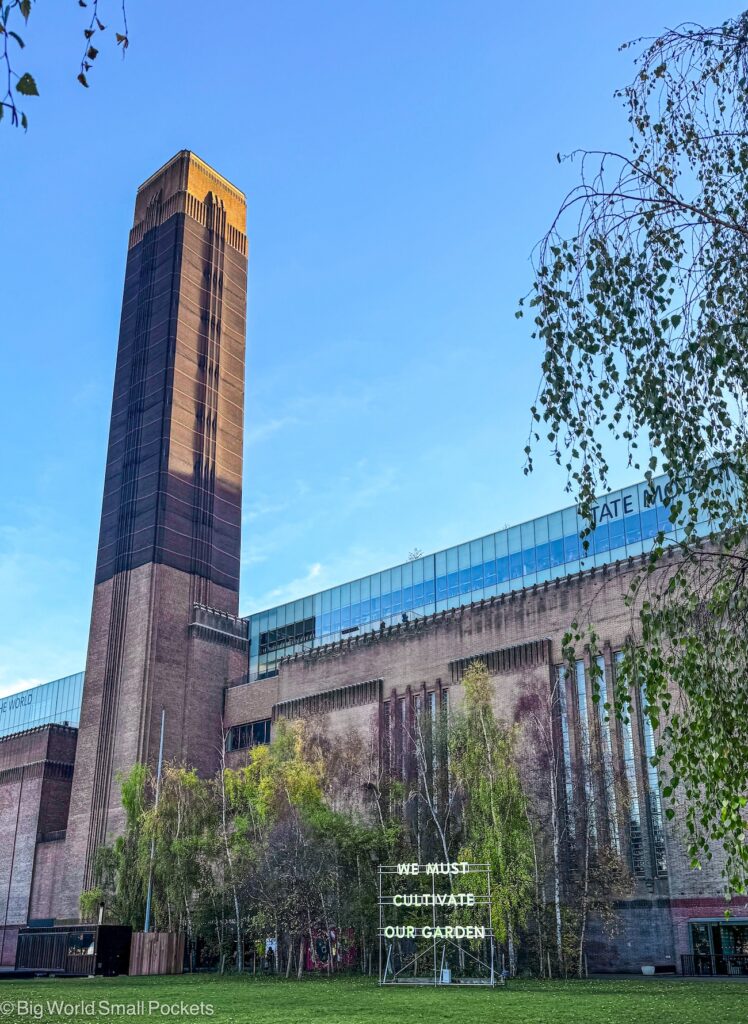

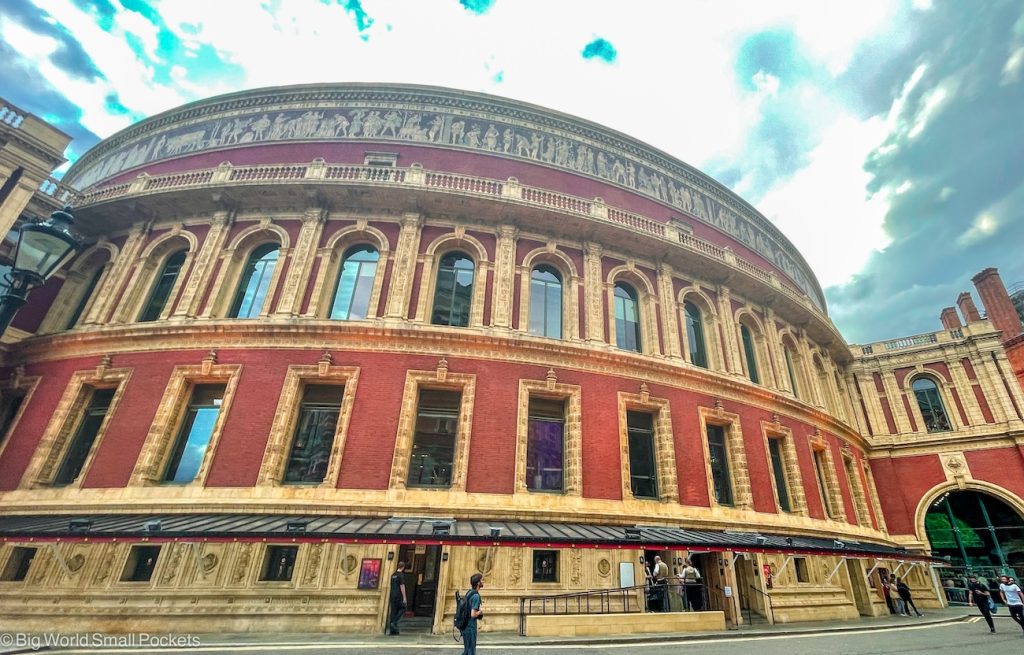
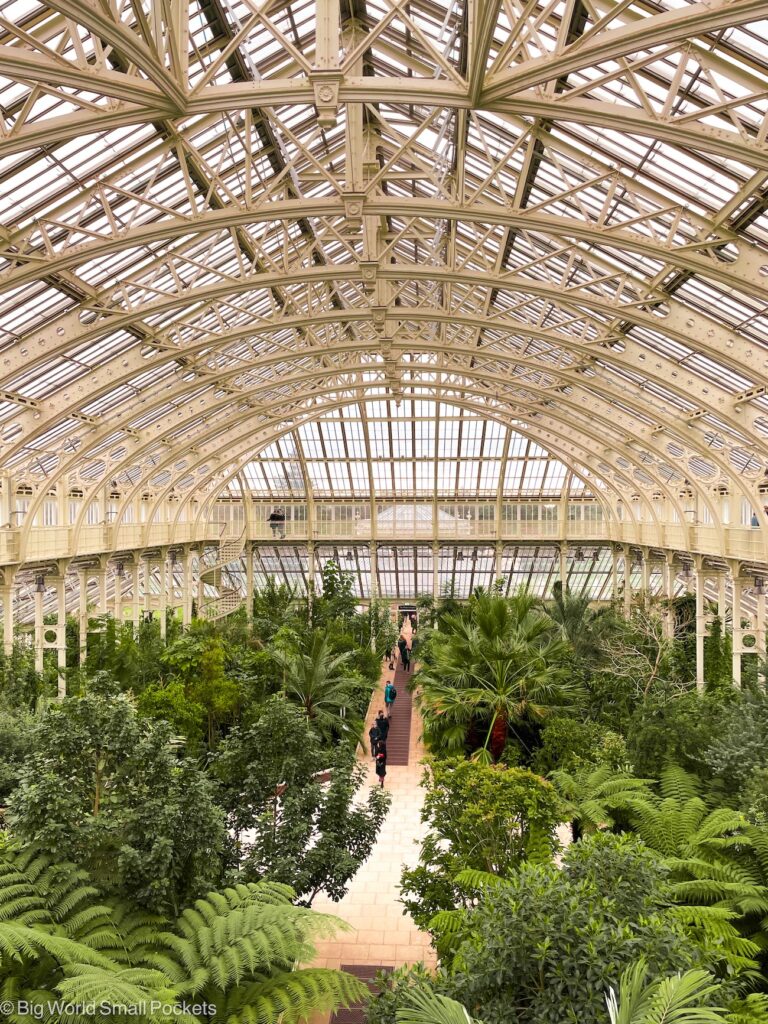
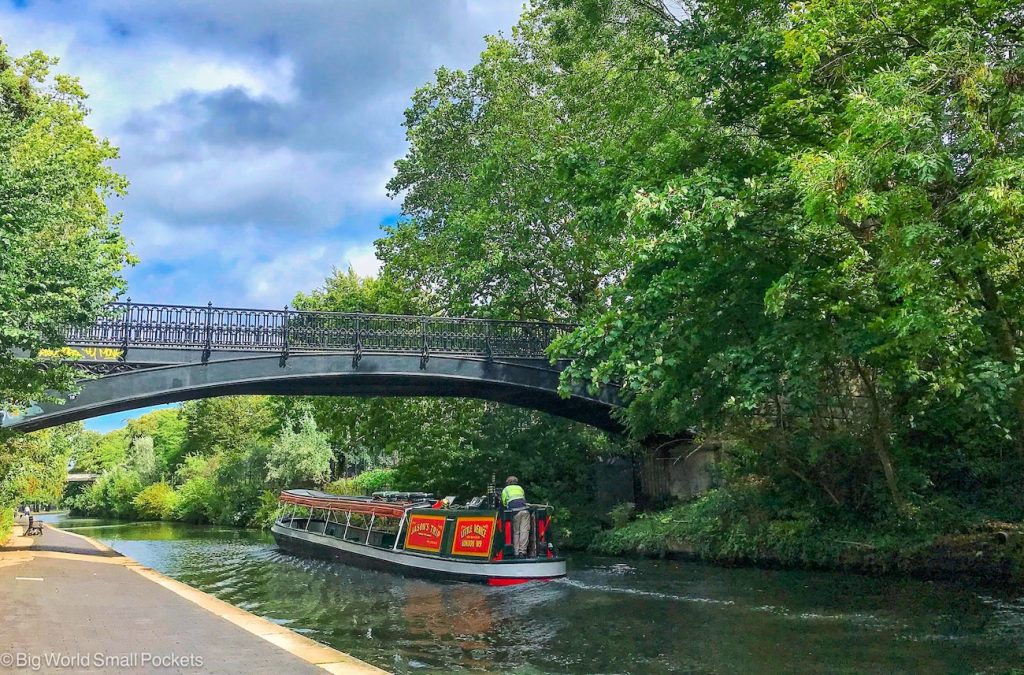

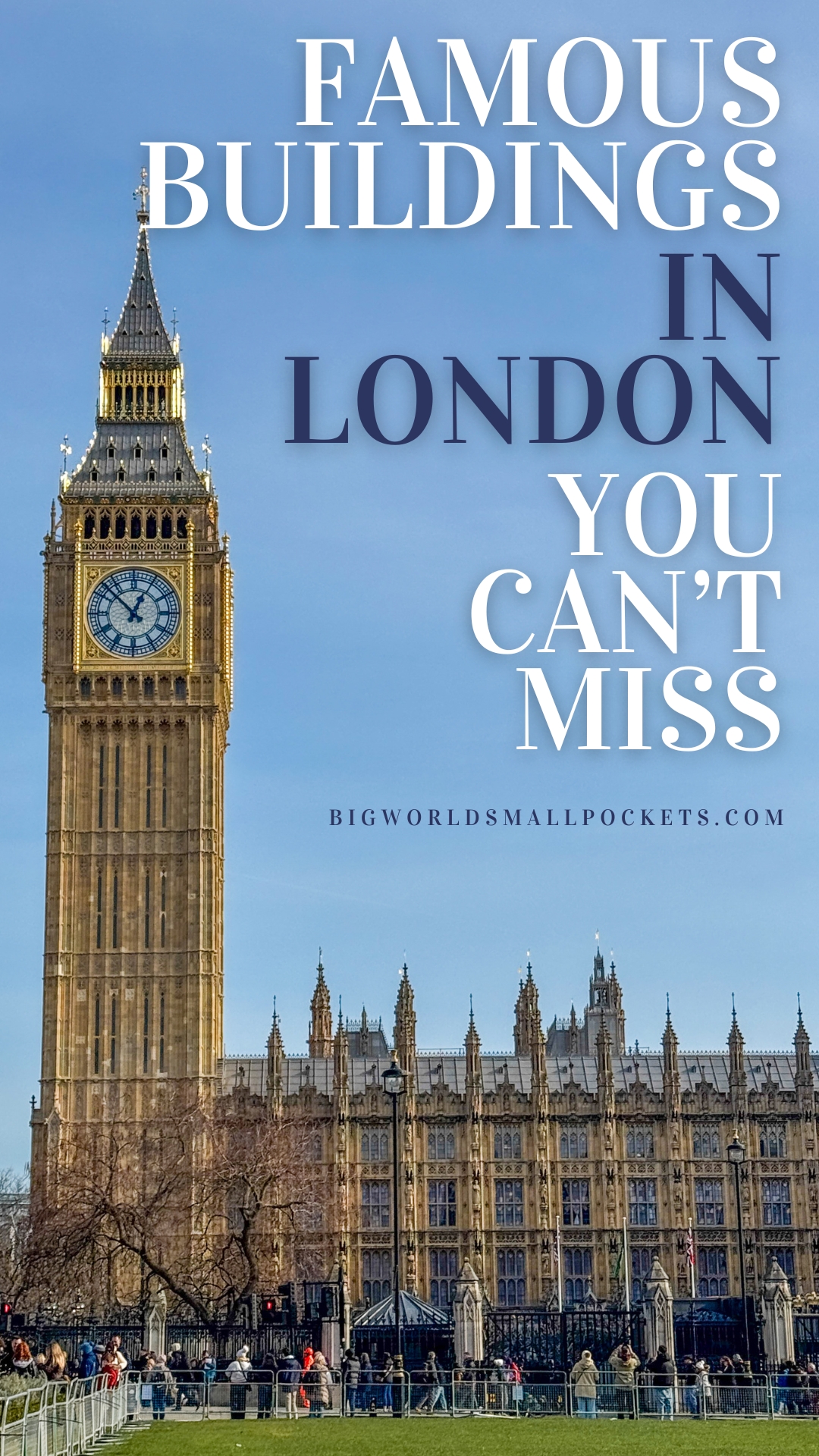
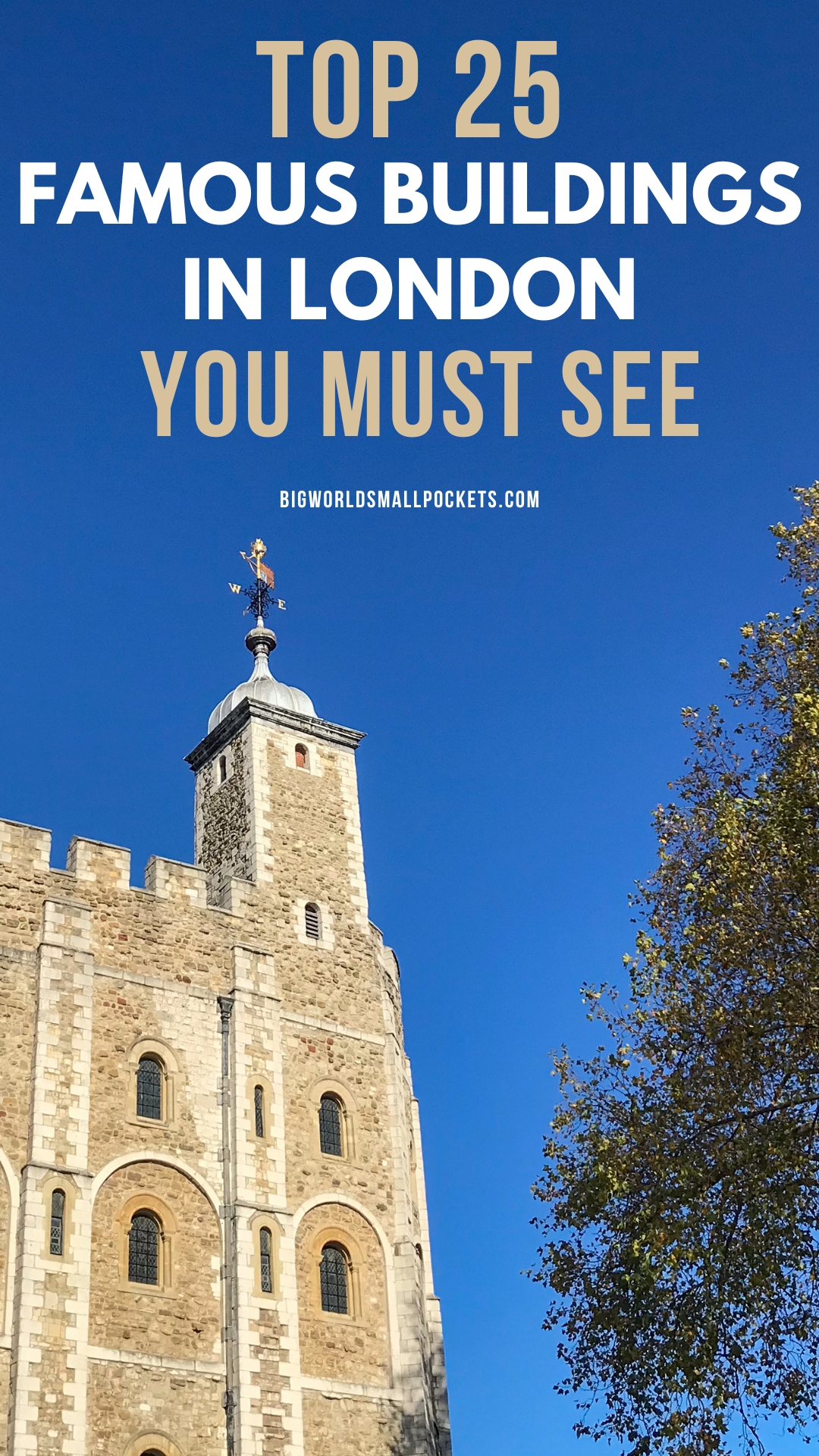
London’s architecture is amazing! Can’t wait to visit it again.
It sure is Saskia! So glad to hear you’re a fan too! Best, Steph